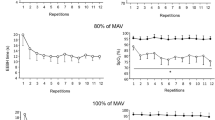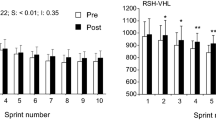Abstract
The purpose of this study was to determine whether the metabolic response and running performance during intermittent graded sprint running were affected by moderate hypobaric hypoxia (H; 2,500 m above sea level) in competitive middle-distance runners. Nine male runners performed intermittent graded sprint running until exhaustion, to evaluate the metabolic response and running performance in H and normobaric normoxia (N). The test constructed of incremental (25 m min−1) 20 s running bouts (4° inclination) interspaced with 100 s recovery periods. Maximal running speed was not different between conditions [453 (7) m min−1 vs. 458 (4) m min−1 in N vs. H]. \(V_{{\text{O}}_{2}}\) at each speed was lower in H than N (ANOVA; P < 0.05). Although, oxygen deficit \({\left({D_{{\text{O}}_{2}}} \right)}\) at each speed was not different between N and H (ANOVA; P = 0.1), total accumulated \(D_{{\text{O}}_{2}}\) in all bouts was significantly higher in H than N [165 (10) ml kg−1 in N and 173 (10) ml kg−1 in H]. The ratio of \(D_{{{\text{O}}_{2}}} \cdot V_{{{\text{O}}_{2}}}^{-1}\) was similar in all bouts, but higher in H than N. These results suggest that intermittent graded sprint running performance is not affected by moderate hypobaria despite a reduction in the energy supplied by aerobic metabolism due to a compensatory increase in the energy supplied by the anaerobic metabolism in competitive middle-distance runners.





Similar content being viewed by others
References
Aaron EA, Seow KC, Johnson BD, Dempsey JA (1992) Oxygen cost of exercise hyperpnea: implications for performance. J Appl Physiol 72:1818–1825
Balsom PD, Gaitanos GC, Ekblom B, Sjodin B (1994) Reduced oxygen availability during high intensity intermittent exercise impairs performance. Acta Physiol Scand 152:279–285
Beltman JGM, de Haan A, Haan H, Gerrits HL, van Mechelen W, Sargeant AJ (2004) Metabolically assessed muscle fibre recruitment in brief isometric contractions at different intensities. Eur J Appl Physiol 92:485–492
Billaut F, Basset F, Giacomoni M, Lemaître F, Tricot V, Falgairette (2006) Effect of high-intensity intermittent cycling sprints on neuromuscular activity. Int J Sports Med 27:25–30
Bogdanis GC, Nevill ME, Boobis LH, Lakomy HK (1996) Contribution of phosphocreatine and aerobic metabolism to energy supply during repeated sprint exercise. J Appl Physiol 80:876–884
Brosnan MJ, Martin DT, Hahn AG, Gore CJ, Hawley JA (2000) Impaired interval exercise responses in elite female cyclists at moderate simulated altitude. J Appl Physiol 89:1819–1824
Calbet JAL, De Paz JA, Garatachea N, Cabeza de Vaca S, Chavarren J (2003) Anaerobic energy provision does not limit Wingate exercise performance in endurance-trained cyclists. J Appl Physiol 94:668–676
Engelen M, Porszasz J, Riley M, Wasserman K, Maehara K, Barstow TJ (1996) Effects of hypoxic hypoxia on O2 uptake and heart rate kinetics during heavy exercise. J Appl Physiol 80:2500–2508
Fellmann N, Bedu M, Spielvogel H, Falgairette G, Van Praagh E, Coudert J (1986) Oxygen debt in submaximal and supramaximal exercise in children at high and low altitude. J Appl Physiol 60:209–215
Gore CJ, Hahn AG, Aughey DT, Martin DT, Ashenden MJ, Clark AP, Granham AD, Roberts AD, Slaters GJ, McKenna MJ (2001) Live high: train low increases muscle buffer capacity and sub-maximal cycling efficiency. Acta Physiol Scand 173:275–286
Haseler LJ, Richardson RS, Videen JS, Hogan MC (1998) Phosphocreatine hydrolysis during sub-maximal exercise: the effect of FIO2. J Appl Physiol 85:1457–1463
Houmard JA, Costill DL, Mitchell JB, Park SH, Chenier TC (1991) The role of anaerobic ability in middle-distance running performance. Eur J Appl Physiol Occup Physiol 62:40–43
Julian CG, Gore CJ, Wilber RL, Daniels JT, Fredericson M, Stray-Gundersen J, Hahn AG, Parisotto R, Levine BD (2004) Intermittent normobaric hypoxia does not alter performance or erythropoietic markers in highly trained distance runners. J Appl Physiol 96:1800–1807
Knuttgen HG, Saltin B (1973) Oxygen uptake, muscle high-energy phosphates, and lactate in exercise under acute hypoxic conditions in man. Acta Physiol Scand 87:368–376
Lacour JR, Bouvant E, Barthélémy JC (1990) Post-competition blood lactate concentrations as indicators of anaerobic energy expenditure during 400-m and 800-m races. Eur J Appl Physiol 61:172–176
Levine BD, Stray-Gundersen J (1997) “Living high-training low”: effect of moderate-altitude acclimatization with low-altitude training on performance. J Appl Physiol 83:102–112
McLellan TM, Kavanagh MF, Jacobs I (1990) The effect of hypoxia on performance during 30 s or 45 s of supramaximal exercise. Eur J Appl Physiol Occup Physiol 60:55–61
McLellan T, Jacobs I, Lewis W (1988) Acute altitude exposure and altered acid–base states II. Effects on exercise performance and muscle and blood lactate. Eur J Appl Physiol 57:445–451
Medbø JI, Mohn AC, Tabata I, Bahr RB, Vaage O, Sejerdted OM (1988) Sejersted. Anaerobic capacity determined by maximal accumulated O2 deficit. J Appl Physiol 64:50–60
Moritani T, Sherman WM, Shibata M, Matsumoto T, Shinohara M (1992) Oxygen availability and motor unit activity in humans. Eur J Appl Physiol Occup Physiol 64:552–556
Newsholme EA (1986) Application of principles of metabolic control to the problem of metabolic limitations in sprinting, middle-distance, and marathon running. Int J Sports Med 7:S66–S70
Nummela A, Rusko H (2000) Acclimatization to altitude and normoxic training improve 400-m running performance at sea level. J Sports Sci 18:411–419
Nummela A, Alberts M, Rijntjes RP, Luhtanen P, Rusko H (1996) Reliability and validity of the maximal anaerobic running test. Int J Sports Med 17:s92–s102
Ogawa T, Ohba K, Nabekura Y, Nagai J, Hayashi K, Wada H, Nishiyasu T (2005) Intermittent short-term graded running performance in middle-distance runners in hypobaric hypoxia. Eur J Appl Physiol 94:254–261
Rusko H, Nummela A (1996) Measurement of maximal and sub-maximal anaerobic performance capacity: concluding chapter. Int J Sports Med 17:S125–S129
Rusko H, Nummela A, Mero A (1993) A new method for the evaluation of anaerobic running power in athletes. Eur J Appl Physiol Occup Physiol 66:97–101
Saltin B, Kim CK, Terrados N, Larsen H, Svedenhag J, Rolf CJ (1995) Morphology, enzyme activities and buffer capacity in leg muscles of Kenyan and Scandinavian runners. Scand J Med Sci Sports 5:222–230
Spencer MR, Gastin PB (2001) Energy system contribution during 200- to 1500-m running in highly trained athletes. Med Sci Sports Exerc 33:157–162
Svedenhag J, Saltin B, Johonson C, Kaijeser L (1991) Aerobic and anaerobic exercise capacities of elite middle-distance runners after two weeks of training at moderate altitude. J Med Sci Sports 11:205–214
Truijens MJ, Toussaint HM, Dow J, Levine BD (2003) Effect of high-intensity hypoxic training on sea-level swimming performances. J Appl Physiol 94:733–743
Weyand PG, Lee CS, Martinez-Ruiz R, Bundle MW, Bellizzi MJ, Wright S (1999) High-speed running performance is largely unaffected by hypoxic reductions in aerobic power. J Appl Physiol 86:2059–2064
Acknowledgments
We are grateful to the University of Tsukuba track-and-field middle-distance team for participation in this study as subjects. This study was supported by grants from University of Tsukuba Research Projects, COE Projects, and the Ministry of Education, Science, and Culture, Japan.
Author information
Authors and Affiliations
Corresponding author
Rights and permissions
About this article
Cite this article
Ogawa, T., Hayashi, K., Ichinose, M. et al. Metabolic response during intermittent graded sprint running in moderate hypobaric hypoxia in competitive middle-distance runners. Eur J Appl Physiol 99, 39–46 (2007). https://doi.org/10.1007/s00421-006-0315-5
Accepted:
Published:
Issue Date:
DOI: https://doi.org/10.1007/s00421-006-0315-5




